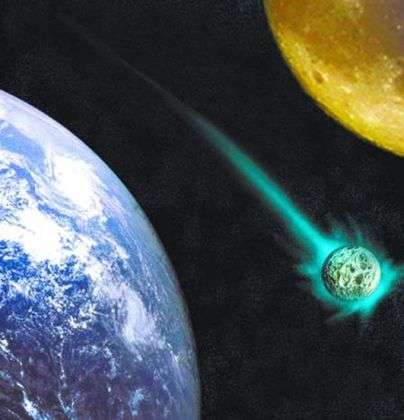一颗航空母舰大小的小行星将在11月8日与地球擦身而过 ,届时它离地球的距离将比月亮还要近。这颗小行星被命名为“2005 YU55”,体积比一艘航母略大,由太阳方向飞近地球。这颗小行星是近35年来类似体积小行星与地球距离最近的一颗。据悉,当这颗小行星与地球擦肩而过时,人的肉眼是无法看清的,但是天文爱好者可以借助6倍直径望远镜观看。
美国国家航空航天局预计,这颗小行星将在美国东部时间8日晚18时28分(北京时间9日早晨7时28分)到达距地球最近点。届时小行星和地球相距不会超过33万公里,小行星飞行中与月亮最近距离不会超过24万公里。相比宇宙宽度,地球与月亮间平均38万公里的间隔如同一条缝隙。这颗小行星恰好要从地月“缝隙”间穿过 。美国国家航空航天局近地天体计划主管表示,这颗小行星绝对不会撞到地球和月亮。天文学家2005年发现这颗小行星,而后一直借助地面天线设备跟踪监测,对其轨道非常了解。

 |
|
The asteroid named 2005 YU55 is being watched by ground antennas as it approaches from the direction of the sun. The last time it came within so-called shouting distance was 200 years ago. |
An asteroid bigger than an aircraft carrier will dart between the Earth and moon on Tuesday - the closest encounter by such a huge rock in 35 years.
But scientists say not to worry. It won't hit.
"We're extremely confident, 100 percent confident, that this is not a threat," said Don Yeomans, manager of NASA's Near Earth Object Program. "But it is an opportunity."
The asteroid named 2005 YU55 is being watched by ground antennas as it approaches from the direction of the sun. The last time it came within so-called shouting distance was 200 years ago.
Closest approach will occur at 6:28 pm EST on Tuesday when the asteroid passes within 325,000 km of Earth. That's closer than the roughly 386,000 km between the Earth and the moon.
The moon will be just under 241,000 km from the asteroid at the time of closest approach.
Both the Earth and moon are safe - "this time", said Jay Melosh, professor of Earth and atmospheric sciences at Purdue University.
If 2005 YU55 were to plow into the home planet, it would blast out a crater 6.4 km across and 510 meters deep, according to Melosh's calculations. Think a magnitude-7 earthquake and 21-meter-high tsunami waves.
Scientists have been tracking the slowly spinning, spherical, dark-colored object since its discovery in 2005, and are positive it won't do any damage.
Smaller objects come close all the time, Yeomans noted, but nothing this big will have ventured so close since 1976. And nothing this large will again until 2028.
Radar observations from California and Puerto Rico will help scientists ascertain whether the asteroid is pockmarked with craters and holds any water-bearing minerals or even frozen water.
Amateur astronomers would need a 15-centimeter-or-bigger telescope and know exactly where to look to spot it.
Astronomers consider 2005 YU55 a C-type asteroid - one containing carbon-based materials. "It's not just a whirling rock like most of them," Yeomans said.
Such objects are believed to have brought carbon-based materials and water to the early Earth, planting the seeds for life. The discovery of water-bearing minerals or ice would support that theory, Yeomans said.
This is the type of asteroid that NASA would want to aim for, with astronauts, Yeomans said, especially if frozen water is found. Such asteroids could serve as watering holes and fueling stations for future explorers, he said.
相关阅读
(Agencies)

(中国日报网英语点津 Helen 编辑)